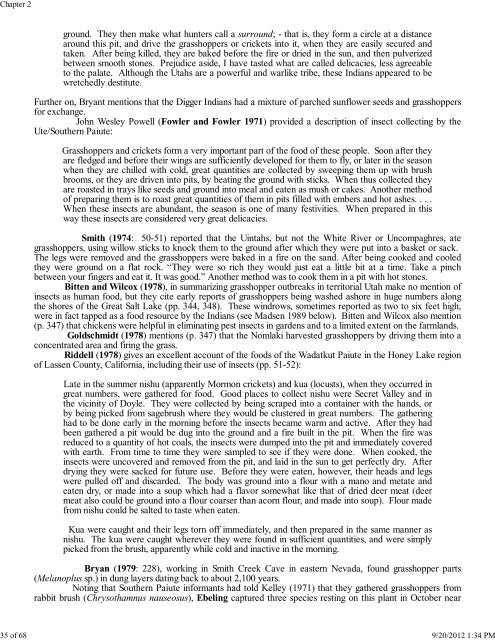Chapter 2. Insect Foods of North American Indigenous Populations ...
Chapter 2. Insect Foods of North American Indigenous Populations ...
Chapter 2. Insect Foods of North American Indigenous Populations ...
You also want an ePaper? Increase the reach of your titles
YUMPU automatically turns print PDFs into web optimized ePapers that Google loves.
<strong>Chapter</strong> 235 <strong>of</strong> 68 9/20/2012 1:34 PMground. They then make what hunters call a surround; - that is, they form a circle at a distancearound this pit, and drive the grasshoppers or crickets into it, when they are easily secured andtaken. After being killed, they are baked before the fire or dried in the sun, and then pulverizedbetween smooth stones. Prejudice aside, I have tasted what are called delicacies, less agreeableto the palate. Although the Utahs are a powerful and warlike tribe, these Indians appeared to bewretchedly destitute.Further on, Bryant mentions that the Digger Indians had a mixture <strong>of</strong> parched sunflower seeds and grasshoppersfor exchange.John Wesley Powell (Fowler and Fowler 1971) provided a description <strong>of</strong> insect collecting by theUte/Southern Paiute:Grasshoppers and crickets form a very important part <strong>of</strong> the food <strong>of</strong> these people. Soon after theyare fledged and before their wings are sufficiently developed for them to fly, or later in the seasonwhen they are chilled with cold, great quantities are collected by sweeping them up with brushbrooms, or they are driven into pits, by beating the ground with sticks. When thus collected theyare roasted in trays like seeds and ground into meal and eaten as mush or cakes. Another method<strong>of</strong> preparing them is to roast great quantities <strong>of</strong> them in pits filled with embers and hot ashes. . . .When these insects are abundant, the season is one <strong>of</strong> many festivities. When prepared in thisway these insects are considered very great delicacies.Smith (1974: 50-51) reported that the Uintahs, but not the White River or Uncompaghres, ategrasshoppers, using willow sticks to knock them to the ground after which they were put into a basket or sack.The legs were removed and the grasshoppers were baked in a fire on the sand. After being cooked and cooledthey were ground on a flat rock. “They were so rich they would just eat a little bit at a time. Take a pinchbetween your fingers and eat it. It was good.” Another method was to cook them in a pit with hot stones.Bitten and Wilcox (1978), in summarizing grasshopper outbreaks in territorial Utah make no mention <strong>of</strong>insects as human food, but they cite early reports <strong>of</strong> grasshoppers being washed ashore in huge numbers alongthe shores <strong>of</strong> the Great Salt Lake (pp. 344, 348). These windrows, sometimes reported as two to six feet high,were in fact tapped as a food resource by the Indians (see Madsen 1989 below). Bitten and Wilcox also mention(p. 347) that chickens were helpful in eliminating pest insects in gardens and to a limited extent on the farmlands.Goldschmidt (1978) mentions (p. 347) that the Nomlaki harvested grasshoppers by driving them into aconcentrated area and firing the grass.Riddell (1978) gives an excellent account <strong>of</strong> the foods <strong>of</strong> the Wadatkut Paiute in the Honey Lake region<strong>of</strong> Lassen County, California, including their use <strong>of</strong> insects (pp. 51-52):Late in the summer nishu (apparently Mormon crickets) and kua (locusts), when they occurred ingreat numbers, were gathered for food. Good places to collect nishu were Secret Valley and inthe vicinity <strong>of</strong> Doyle. They were collected by being scraped into a container with the hands, orby being picked from sagebrush where they would be clustered in great numbers. The gatheringhad to be done early in the morning before the insects became warm and active. After they hadbeen gathered a pit would be dug into the ground and a fire built in the pit. When the fire wasreduced to a quantity <strong>of</strong> hot coals, the insects were dumped into the pit and immediately coveredwith earth. From time to time they were sampled to see if they were done. When cooked, theinsects were uncovered and removed from the pit, and laid in the sun to get perfectly dry. Afterdrying they were sacked for future use. Before they were eaten, however, their heads and legswere pulled <strong>of</strong>f and discarded. The body was ground into a flour with a mano and metate andeaten dry, or made into a soup which had a flavor somewhat like that <strong>of</strong> dried deer meat (deermeat also could be ground into a flour coarser than acorn flour, and made into soup). Flour madefrom nishu could be salted to taste when eaten.Kua were caught and their legs torn <strong>of</strong>f immediately, and then prepared in the same manner asnishu. The kua were caught wherever they were found in sufficient quantities, and were simplypicked from the brush, apparently while cold and inactive in the morning.Bryan (1979: 228), working in Smith Creek Cave in eastern Nevada, found grasshopper parts(Melanoplus sp.) in dung layers dating back to about 2,100 years.Noting that Southern Paiute informants had told Kelley (1971) that they gathered grasshoppers fromrabbit brush (Chrysothamnus nauseosus), Ebeling captured three species resting on this plant in October near
















